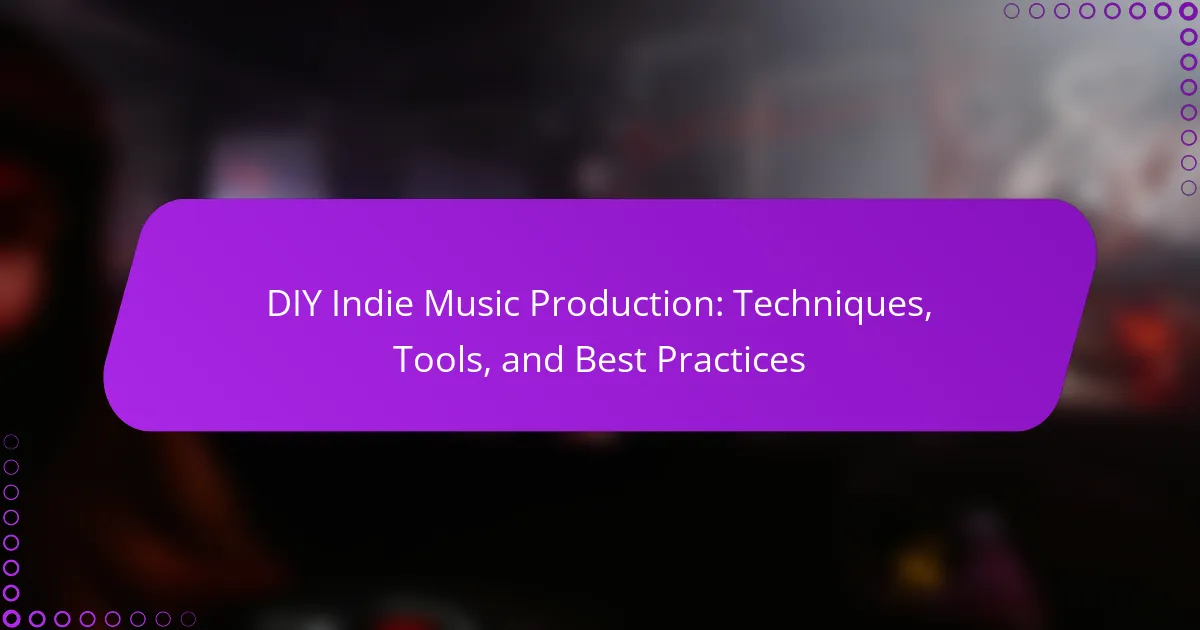DIY indie music production empowers artists to create music on their own terms. This article explores key techniques like home recording and layering tracks, essential tools such as digital audio workstations and audio interfaces, remote collaboration strategies, common challenges faced by producers, and emerging trends in the industry. By focusing on quality tools and refining skills, musicians can enhance their production quality and maintain creative control.
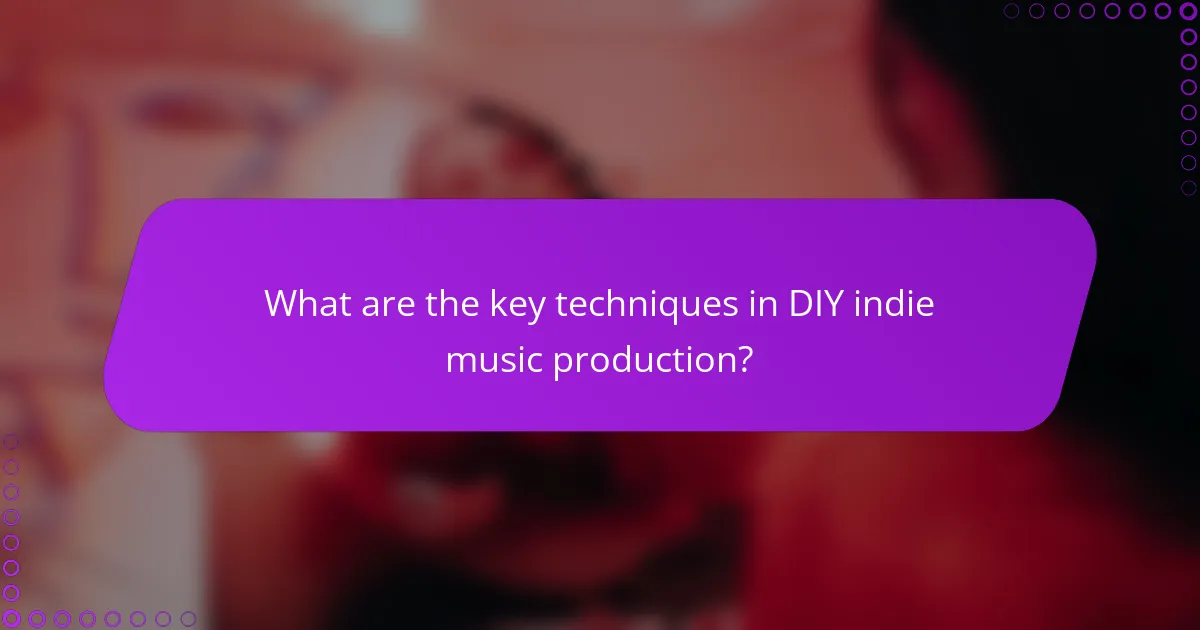
What are the key techniques in DIY indie music production?
The key techniques in DIY indie music production include home recording, digital audio workstations (DAWs), and layering tracks. Home recording allows artists to create music in a flexible environment. DAWs, like Ableton Live or GarageBand, provide essential tools for editing and mixing. Layering tracks enhances depth and richness in sound, enabling unique compositions. Additionally, utilizing effects and plugins can further refine the audio quality, making it distinct and polished.
How do recording techniques vary for different genres?
Recording techniques vary significantly across genres to enhance the unique sound and feel of each style. For instance, rock music often employs layered guitar tracks and dynamic drum recordings, while electronic music relies on digital sampling and synthesis.
In genres like jazz, live recording with minimal overdubs captures the spontaneous essence of performances. Conversely, pop music frequently utilizes polished production techniques, including vocal tuning and extensive post-production editing.
Additionally, genres such as classical music prioritize capturing the natural acoustics of instruments in a space, often using stereo miking techniques. Each genre’s distinct characteristics dictate the choice of recording methods, ensuring the final product resonates with its intended audience.
Which mixing strategies enhance the final sound?
Using a variety of mixing strategies can significantly enhance the final sound in DIY indie music production. Techniques such as panning, equalization, and compression allow for a more balanced and dynamic mix.
Panning creates a sense of space by distributing sounds across the stereo field. Equalization adjusts frequency levels to ensure clarity and separation among instruments. Compression controls the dynamic range, making quieter sounds more audible while preventing distortion from louder sounds.
Additionally, using reverb and delay can add depth and atmosphere, enriching the overall listening experience. Experimenting with these strategies helps achieve a polished and professional sound.
What role does mastering play in music production?
Mastering is crucial in music production as it enhances the overall sound quality and ensures consistency across tracks. It involves final adjustments to levels, EQ, and dynamics, making the music ready for distribution. Proper mastering can elevate a mix, making it sound polished and professional. It also ensures compatibility across various playback systems, maintaining audio integrity.
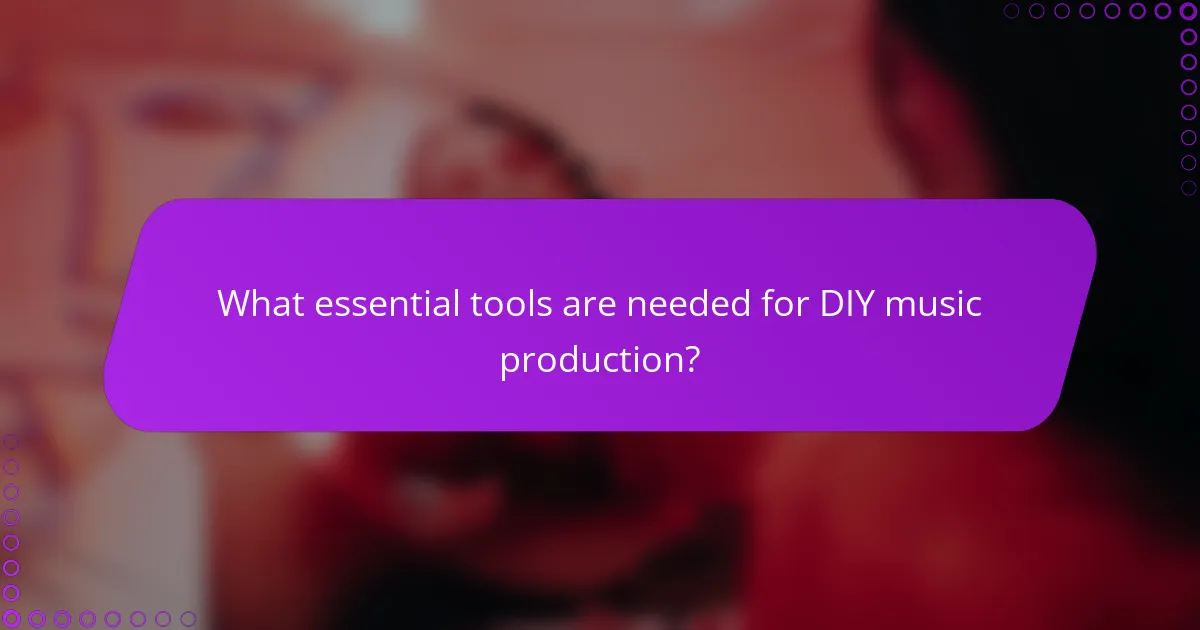
What essential tools are needed for DIY music production?
Essential tools for DIY music production include a digital audio workstation (DAW), audio interface, microphones, studio monitors, and headphones. These tools facilitate recording, mixing, and mastering music effectively.
1. Digital Audio Workstation (DAW) | Software for recording and editing audio.
2. Audio Interface | Connects instruments and microphones to a computer.
3. Microphones | Captures vocals and instruments.
4. Studio Monitors | Provides accurate sound reproduction.
5. Headphones | Ensures detailed monitoring during production.
Which digital audio workstations (DAWs) are most popular among indie producers?
The most popular digital audio workstations (DAWs) among indie producers include Ableton Live, FL Studio, Logic Pro, and Pro Tools. These DAWs are favored for their user-friendly interfaces, versatile features, and strong community support.
| DAW | Key Features | Target Users |
|——————|———————————-|———————-|
| Ableton Live | Session view, real-time editing | Electronic music producers |
| FL Studio | Pattern-based workflow | Beginners, beat makers |
| Logic Pro | Comprehensive MIDI support | Mac users, songwriters |
| Pro Tools | Industry-standard audio editing | Professional studios |
What hardware instruments and equipment are commonly used?
Common hardware instruments and equipment for DIY indie music production include microphones, audio interfaces, MIDI controllers, studio monitors, and headphones. These tools enhance recording quality and creative expression.
| Equipment Type | Purpose | Example Model |
|———————-|—————————————–|———————|
| Microphone | Captures vocals and instruments | Shure SM58 |
| Audio Interface | Connects instruments to computer | Focusrite Scarlett 2i2 |
| MIDI Controller | Controls virtual instruments | Akai MPK Mini |
| Studio Monitors | Provides accurate sound reproduction | Yamaha HS5 |
| Headphones | Ensures precise monitoring | Audio-Technica ATH-M50x |
How do plugins and virtual instruments contribute to production quality?
Plugins and virtual instruments significantly enhance production quality by offering diverse sounds and effects. They enable indie musicians to create professional-sounding tracks without expensive studio time.
Plugins provide effects like reverb, compression, and EQ, allowing for precise sound shaping. Virtual instruments expand the sonic palette, offering realistic emulations of acoustic instruments. This versatility supports creative experimentation, leading to unique soundscapes.
Moreover, plugins often include features like MIDI capabilities and automation, which streamline the production process. As a result, artists can achieve a polished final product that stands out in the competitive indie music scene.
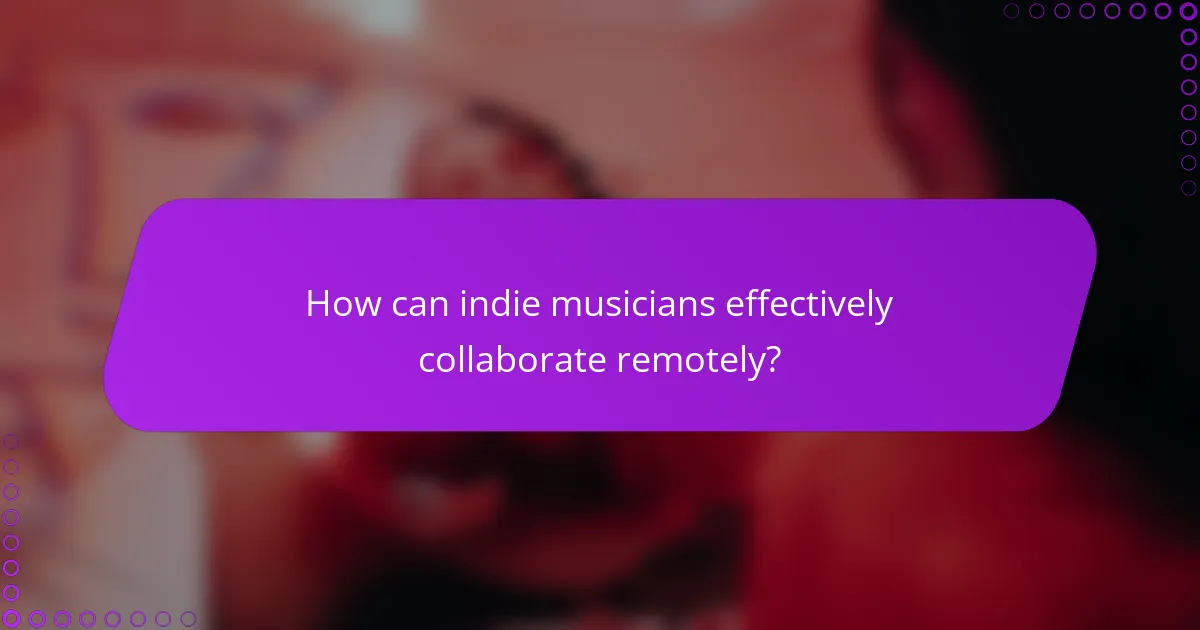
How can indie musicians effectively collaborate remotely?
Indie musicians can effectively collaborate remotely by utilizing digital tools and establishing clear communication. Key techniques include using cloud-based platforms for file sharing, video conferencing for real-time discussions, and project management software to track progress.
1. Choose a digital audio workstation (DAW) that supports collaboration, such as Ableton Live or Logic Pro.
2. Utilize file-sharing services like Dropbox or Google Drive for easy access to tracks and project files.
3. Schedule regular virtual meetings to discuss ideas and provide feedback.
4. Set clear deadlines and responsibilities to maintain workflow and accountability.
5. Experiment with online collaboration platforms like Soundtrap or BandLab for seamless music creation.
6. Foster a supportive environment by encouraging open communication and creativity.
What platforms facilitate online collaboration for music projects?
Platforms that facilitate online collaboration for music projects include Soundtrap, BandLab, Splice, and Audiomack. These tools allow musicians to create, edit, and share music remotely. Soundtrap offers real-time collaboration and a user-friendly interface. BandLab provides social networking features, enabling artists to connect and collaborate easily. Splice focuses on sample sharing and project collaboration, while Audiomack supports music distribution and promotion. Each platform enhances the DIY indie music production process through unique attributes like cloud storage and integrated tools for mixing and mastering.
How do communication tools enhance the collaborative process?
Communication tools significantly enhance the collaborative process by facilitating real-time interaction and information sharing among team members. These tools streamline workflows, allowing for quicker decision-making and creative input. For instance, platforms like Slack and Trello enable users to exchange ideas and track project progress efficiently. Additionally, video conferencing tools foster a sense of connection, essential for remote teams, by enabling face-to-face discussions. Effective communication tools ultimately lead to higher productivity and a more cohesive team environment.
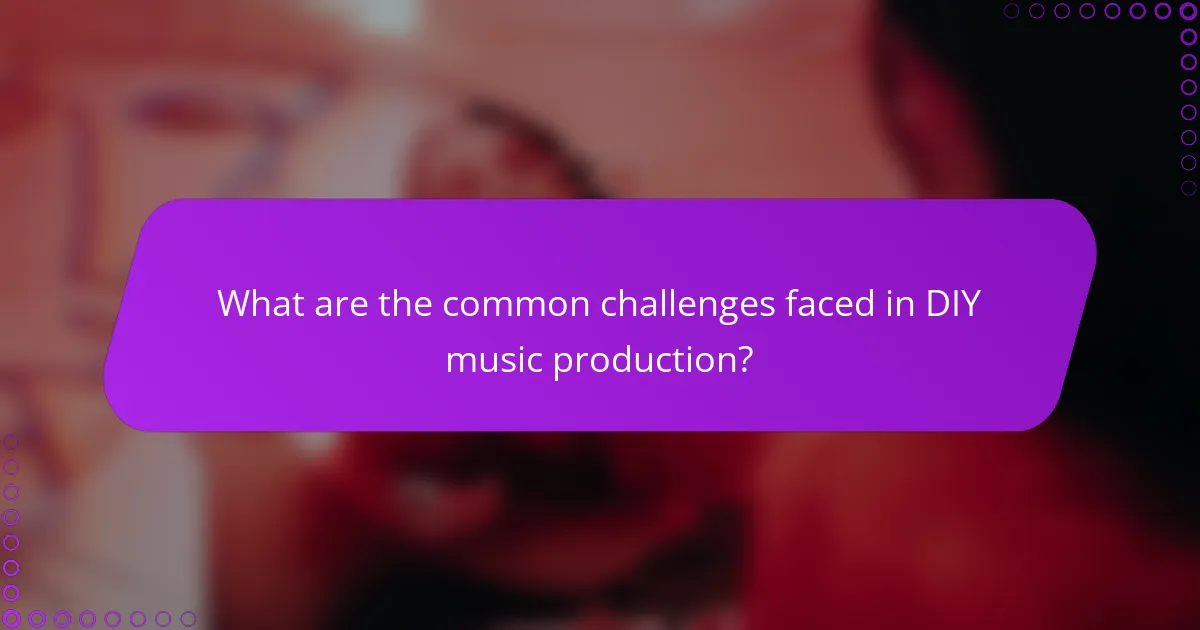
What are the common challenges faced in DIY music production?
Common challenges in DIY music production include technical skills, equipment selection, sound quality, time management, and creative blocks. Many producers struggle with learning software and hardware, leading to frustrating experiences. Choosing the right tools can be overwhelming due to the vast array available, impacting the final sound quality. Time constraints often hinder the creative process, making it difficult to produce polished tracks. Additionally, creative blocks can stifle innovation, leaving producers feeling stuck. Addressing these challenges is crucial for successful DIY music production.
How can budget constraints impact production quality?
Budget constraints can significantly lower production quality in DIY indie music. Limited funds restrict access to high-quality equipment, professional studios, and skilled personnel. Consequently, artists may resort to subpar tools or software, leading to inferior sound and production values. Furthermore, budget limitations can reduce the time available for mixing and mastering, resulting in a less polished final product. Ultimately, these factors can hinder an artist’s ability to compete in a crowded market, affecting their reach and impact.
What technical skills are essential for overcoming production hurdles?
Essential technical skills for overcoming production hurdles in DIY indie music include audio editing, mixing, and mastering. Proficiency in digital audio workstations (DAWs) is crucial for effective sound manipulation. Understanding signal flow and acoustics enhances recording quality. Familiarity with MIDI programming allows for creative flexibility in arrangements. Moreover, knowledge of music theory aids in composing and arranging tracks efficiently.
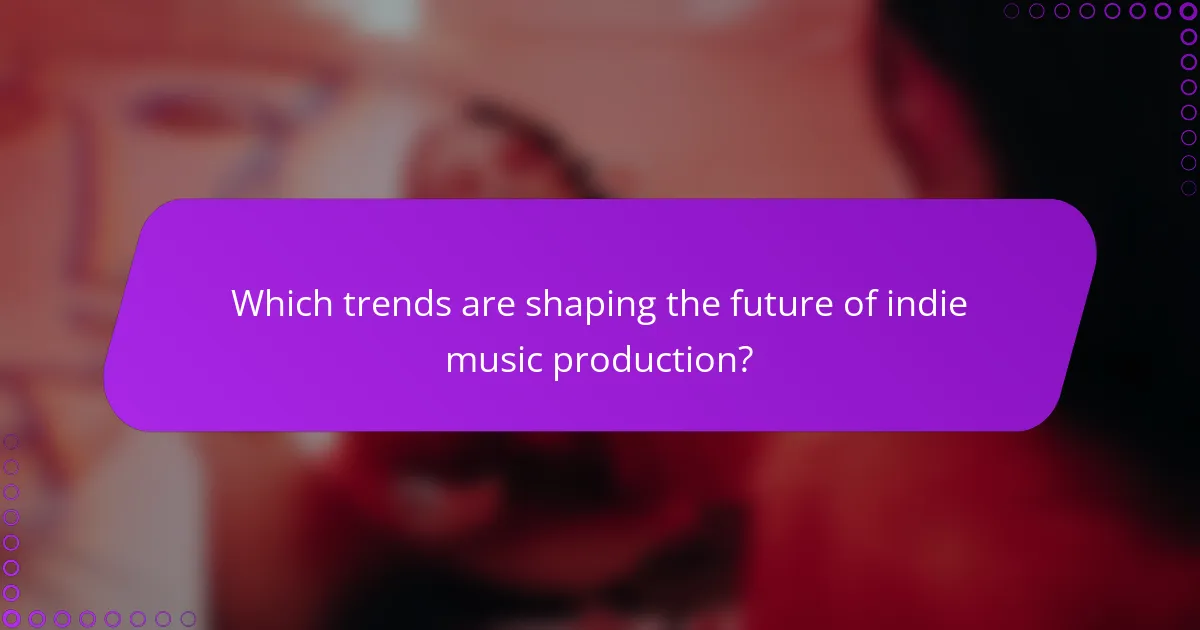
Which trends are shaping the future of indie music production?
Emerging technologies and shifting consumer preferences are significantly shaping indie music production. Key trends include the rise of affordable digital audio workstations, increased accessibility of high-quality recording equipment, and the growing popularity of online collaboration tools.
DIY production is increasingly favored, allowing artists to maintain creative control. As a result, more musicians are utilizing social media platforms for promotion, directly engaging with audiences. Additionally, the integration of artificial intelligence in music creation is becoming more prevalent, offering innovative tools for mixing and mastering.
These trends reflect a shift towards a more democratized music industry, where independence and creativity thrive. The ability to produce and distribute music without traditional gatekeepers empowers artists to explore unique sounds and styles.
How is technology influencing music creation and distribution?
Technology significantly influences music creation and distribution by democratizing access and enhancing production capabilities. Digital audio workstations (DAWs) enable musicians to produce high-quality tracks independently. Cloud-based platforms facilitate collaboration across distances, allowing artists to co-create seamlessly. Streaming services revolutionize distribution, providing artists with direct access to global audiences. Social media platforms serve as marketing tools, helping indie musicians build their brand and connect with fans. As a result, the barriers to entry in the music industry have diminished, empowering a diverse range of voices.
What emerging genres are gaining popularity in the indie scene?
Emerging genres gaining popularity in the indie scene include bedroom pop, lo-fi hip hop, and synthwave. Bedroom pop blends DIY aesthetics with intimate lyrics, attracting younger audiences. Lo-fi hip hop offers chill beats ideal for studying, while synthwave revives 80s sounds, appealing to nostalgia. These genres reflect evolving listener preferences and technological advancements in music production.

What best practices should indie musicians follow for successful production?
Indie musicians should focus on planning, using quality tools, and refining their skills for successful production. Prioritize pre-production by organizing song structures and arrangements. Invest in good recording equipment to enhance sound quality. Utilize digital audio workstations (DAWs) effectively for mixing and editing. Collaborate with other musicians for fresh perspectives. Regularly seek feedback to improve and iterate on your work.
How can artists effectively market their DIY music projects?
Artists can effectively market their DIY music projects by leveraging social media, engaging with local communities, and utilizing digital distribution platforms. Building a strong online presence is crucial. Use platforms like Instagram and TikTok to showcase your music and connect with fans. Collaborate with other local artists to expand your reach and gain exposure.
Utilizing digital distribution services such as DistroKid or TuneCore can help get your music on major streaming platforms. Consider creating visually appealing album art and promotional materials to attract attention.
Engage your audience through live performances, whether virtual or in-person, to create a personal connection. Regularly update your followers on new releases and behind-the-scenes content to maintain interest.
Lastly, consider email marketing to keep your fans informed about upcoming projects, merchandise, and events. Building a loyal fanbase takes time, but consistent effort in these areas can yield significant results.
What are the most common mistakes to avoid in DIY music production?
Common mistakes in DIY music production include neglecting proper planning, skipping sound quality checks, and overusing effects. Many producers fail to organize their projects, leading to confusion and inefficiency. Additionally, overlooking the importance of mixing and mastering can result in subpar final products. Investing time in learning the software and techniques is crucial for achieving professional results.
Which strategies can optimize the creative process in music production?
To optimize the creative process in music production, implement structured workflows, embrace collaboration, and utilize technology effectively. Establishing a routine fosters consistency, while collaborative efforts can bring fresh perspectives. Leveraging tools like digital audio workstations enhances efficiency and creativity.
